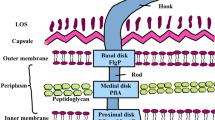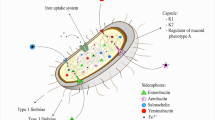Abstract
Campylobacter jejuni is the most common bacterial cause of foodborne diarrheal disease worldwide and is among the antimicrobial resistant “priority pathogens” that pose greatest threat to public health. The genomes of two C. jejuni isolated from poultry meat sold on the retail market in Southern Brazil phenotypically characterized as multidrug-resistant (CJ100) and susceptible (CJ104) were sequenced and analyzed by bioinformatic tools. The isolates CJ100 and CJ104 showed distinct multilocus sequence types (MLST). Comparative genomic analysis revealed a large number of single nucleotide polymorphisms, rearrangements, and inversions in both genomes, in addition to virulence factors, genomic islands, prophage sequences, and insertion sequences. A circular 103-kilobase megaplasmid carrying virulence factors was identified in the genome of CJ100, in addition to resistance mechanisms to aminoglycosides, beta-lactams, macrolides, quinolones, and tetracyclines. The molecular characterization of distinct phenotypes of foodborne C. jejuni and the discovery of a novel virulence megaplasmid provide useful data for pan-genome and large-scale studies to monitor the virulent C. jejuni in poultry meat is warranted.





Similar content being viewed by others
References
Kinana AD, Cardinale E, Tall F, et al (2006) Genetic diversity and quinolone resistance in Campylobacter jejuni isolates from Poultry in Senegal. Appl Environ Microbiol 72:3309–3313. https://doi.org/10.1128/AEM.72.5.3309-3313.2006
Frazão MR, Medeiros MIC, Da Silva Duque S, Falcão JP (2017) Pathogenic potential and genotypic diversity of Campylobacter jejuni: a neglected food-borne pathogen in Brazil. J Med Microbiol 66:350–359. https://doi.org/10.1099/jmm.0.000424
Young KT, Davis LM, DiRita VJ (2007) Campylobacter jejuni: molecular biology and pathogenesis. Nat Rev Microbiol 5:665–679
Wieczorek K, Osek J (2013) Antimicrobial Resistance Mechanisms among Campylobacter. Biomed Res Int 2013:1–12. https://doi.org/10.1155/2013/340605
Silva WC, Targino BN, Mendonça RS, et al (2018) Campylobacter: an overview of cases, occurrence in food, contamination sources, and antimicrobial resistance in Brazil. Food Rev Int 34:364–389
Fouts DE, Mongodin EF, Mandrell RE, et al (2005) Major structural differences and novel potential virulence mechanisms from the genomes of multiple campylobacter species. PLoS Biol 3:e15. https://doi.org/10.1371/journal.pbio.0030015
CDC- Centers for Disease Control and Prevention (2017) Campylobacter (Campylobacteriosis) | Campylobacter | CDC. https://www.cdc.gov/campylobacter/index.html
Bolton DJ (2015) Campylobacter virulence and survival factors. Food Microbiol. 48:99–108
Würfel SFR, da Silva WP, de Oliveira MG, et al (2019) Genetic diversity of Campylobacter jejuni and Campylobacter coli isolated from poultry meat products sold on the retail market in Southern Brazil. Poult Sci 98:932–939. https://doi.org/10.3382/ps/pey365
Bankevich A, Nurk S, Antipov D, et al (2012) SPAdes: a new genome assembly algorithm and its applications to single-cell sequencing. J Comput Biol 19:455–477. https://doi.org/10.1089/cmb.2012.0021
Lin SH, Liao YC (2013) CISA: contig integrator for sequence assembly of bacterial genomes. PLoS ONE. https://doi.org/10.1371/journal.pone.0060843
Lu CL, Chen KT, Huang SY, Chiu HT (2014) Car: contig assembly of prokaryotic draft genomes using rearrangements. BMC Bioinform 15:381. https://doi.org/10.1186/s12859-014-0381-3
Kosugi S, Hirakawa H, Tabata S (2015) GMcloser: closing gaps in assemblies accurately with a likelihood-based selection of contig or long-read alignments. Bioinformatics 31:3733–41. https://doi.org/10.1093/bioinformatics/btv465
Piro VC, Faoro H, Weiss VA, et al (2014) FGAP: an automated gap closing tool. BMC Res Notes 7:371. https://doi.org/10.1186/1756-0500-7-371
Kremer FS, Eslabão MR, Dellagostin OA, Pinto L da S (2016) Genix: a new online automated pipeline for bacterial genome annotation. FEMS Microbiol Lett 363:263
Rutherford K, Parkhill J, Crook J, et al (2000) Artemis: sequence visualization and annotation. Bioinformatics 16:944–945. https://doi.org/10.1093/bioinformatics/16.10.944
Zhou Y, Liang Y, Lynch KH, et al (2011) PHAST: a fast phage search tool. Nucleic Acids Res 39:W347–W352. https://doi.org/10.1093/nar/gkr485
Bertelli C, Laird MR, Williams KP, et al (2017) IslandViewer 4: expanded prediction of genomic islands for larger-scale datasets. Nucleic Acids Res 45:W30–W35. https://doi.org/10.1093/nar/gkx343
Edgar RC (2004) MUSCLE: multiple sequence alignment with high accuracy and high throughput. Nucleic Acids Res 32:1792–1797. https://doi.org/10.1093/nar/gkh340
Hoffmann S, Otto C, Kurtz S, et al (2009) Fast mapping of short sequences with mismatches, insertions and deletions using index structures. PLoS Comput Biol 5:e1000502. https://doi.org/10.1371/journal.pcbi.1000502
Li H, Handsaker B, Wysoker A, et al (2009) The sequence alignment/map format and SAMtools. Bioinformatics 25:2078–9. https://doi.org/10.1093/bioinformatics/btp352
Reumers J, Schymkowitz J, Ferkinghoff-Borg J, et al (2005) SNPeffect: a database mapping molecular phenotypic effects of human non-synonymous coding SNPs. Nucleic Acids Res. 33:D527-3
Tatusov RL (2000) The COG database: a tool for genome-scale analysis of protein functions and evolution. Nucleic Acids Res 28:33–36. https://doi.org/10.1093/nar/28.1.33
Angiuoli S V., Salzberg SL (2011) Mugsy: fast multiple alignment of closely related whole genomes. Bioinformatics 27:334–342. https://doi.org/10.1093/bioinformatics/btq665
Letunic I, Bork P (2016) Interactive tree of life (iTOL) v3: an online tool for the display and annotation of phylogenetic and other trees. Nucleic Acids Res 44:W242–W245. https://doi.org/10.1093/nar/gkw290
Konkel ME, Hayes SF, Joens LA, Cieplak W (1992) Characteristics of the internalization and intracellular survival of Campylobacter jejuni in human epithelial cell cultures. Microb Pathog 13:357–370. https://doi.org/10.1016/0882-4010(92)90079-4
Poly F, Read TD, Chen YH, et al (2008) Characterization of two Campylobacter jejuni strains for use in volunteer experimental-infection studies. Infect Immun 76:5655–5667. https://doi.org/10.1128/IAI.00780-08
Dingle KE, Colles FM, Ure R, et al (2002) Molecular characterization of Campylobacter jejuni clones: a basis for epidemiologic investigation. Emerg Infect Dis 8:949–955
Iovine NM (2013) Resistance mechanisms in Campylobacter jejuni. Virulence 4:230–240
Corcoran D, Quinn T, Cotter L, Fanning S (2006) An investigation of the molecular mechanisms contributing to high-level erythromycin resistance in Campylobacter. Int J Antimicrob Agents 27:40–45. https://doi.org/10.1016/j.ijantimicag.2005.08.019
Cagliero C, Mouline C, Cloeckaert A, Payot S (2006) Synergy between efflux pump CmeABC and modifications in ribosomal proteins L4 and L22 in conferring macrolide resistance in Campylobacter jejuni and Campylobacter coli. Antimicrob Agents Chemother 50:3893–3896. https://doi.org/10.1128/AAC.00616-06
Lin J, Cagliero C, Guo B, et al (2005) Bile salts modulate expression of the CmeABC multidrug efflux pump in Campylobacter jejuni. J Bacteriol 187:7417–7424. https://doi.org/10.1128/JB.187.21.7417-7424.2005
Sampson TR, Weiss DS (2014) CRISPR-Cas systems: new players in gene regulation and bacterial physiology. Front Cell Infect Microbiol 4:37. https://doi.org/10.3389/fcimb.2014.00037
Gibreel A, Sköld O, Taylor DE (2004) Characterization of plasmid-mediated aphA-3 kanamycin resistance in Campylobacter jejuni. Microb Drug Resist 10:98–105. https://doi.org/10.1109/ICETET.2008.78
Gilbert M, Brisson JR, Karwaski MF, et al (2000) Biosynthesis of ganglioside mimics in Campylobacter jejuni OH4384. Identification of the glycosyltransferase genes, enzymatic synthesis of model compounds, and characterization of nanomole amounts by 600-MHz 1H and 13C NMR analysis. J Biol Chem 275:3896–3906. https://doi.org/10.1074/jbc.275.6.3896
Parkhill J, Wren BW, Mungall K, et al (2000) The genome sequence of the food-borne pathogen Campylobacter jejuni reveals hypervariable sequences. Nature 403:665–668. https://doi.org/10.1038/35001088
Cao TB, Saier J (2001) Conjugal type IV macromolecular transfer systems of Gram-negative bacteria: organismal distribution, structural constraints and evolutionary conclusions. Microbiology 147:3201–3214
Hickey TE, McVeigh AL, Scott DA, et al (2000) Campylobacter jejuni cytolethal distending toxin mediates release of interleukin-8 from intestinal epithelial cells. Infect Immun 68:6535–6541. https://doi.org/10.1128/IAI.68.12.6535-6541.2000
Babakhani FK, Bradley GA, Joens LA (1993) Newborn piglet model for campylobacteriosis. Infect Immun 61:3466–3475
Acknowledgements
This study was financed in party by the Coordenação de Aperfeiçoamento de Pessoal de Nível Superior—Brasil (CAPES—Finance Code 001), Conselho Nacional de Desenvolvimento Científico e Tecnológico (CNPq-Grant 309101/2016-6), and Fundação de Amparo à Pesquisa do Estado do Rio Grande do Sul (FAPERGS-Grant 17/2551-0000956-8).
Author information
Authors and Affiliations
Corresponding author
Ethics declarations
Conflict of interest
The authors declare that they have no conflicts of interest.
Additional information
Publisher's Note
Springer Nature remains neutral with regard to jurisdictional claims in published maps and institutional affiliations.
Nucleotide sequence accession numbers
Sequence data from this article have been deposited with the DDBJ/EMBL/GenBank Data Libraries under Accessions CP023343.1 (chromosome, C. jejuni strain 104), CP023446.1 (chromosome, C. jejuni strain 100), and CP023447.1 (plasmid pJc100).
Electronic supplementary material
Below is the link to the electronic supplementary material.
Rights and permissions
About this article
Cite this article
de Fátima Rauber Würfel, S., Jorge, S., de Oliveira, N.R. et al. Campylobacter jejuni isolated from poultry meat in Brazil: in silico analysis and genomic features of two strains with different phenotypes of antimicrobial susceptibility. Mol Biol Rep 47, 671–681 (2020). https://doi.org/10.1007/s11033-019-05174-y
Received:
Accepted:
Published:
Issue Date:
DOI: https://doi.org/10.1007/s11033-019-05174-y




